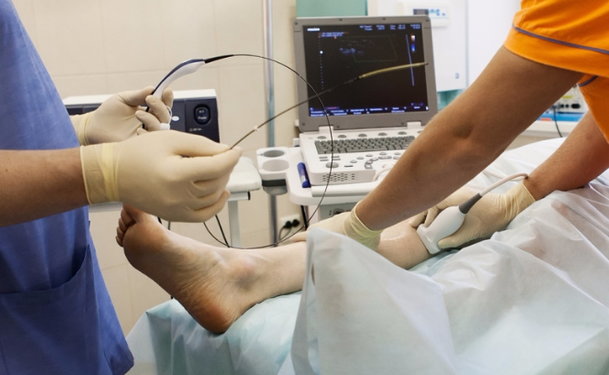Endovenous radiofrequency ablation, also known as RFA, is a treatment for varicose veins in the legs, a condition that affects a large number of adults. This procedure uses heat to close off the larger superficial veins, those closer to the surface of the skin. This includes the great, small and accessory saphenous veins.
The procedure is less invasive than other varicose vein treatments such as vein stripping, and requires only a tiny skin puncture. Radiofrequency ablation takes about 45 to 60 minutes per leg. Your doctor can perform it in the office or at an ambulatory surgery setting using local anesthesia.
Endovenous radiofrequency ablation may also be used alongside other procedures such as sclerotherapy and phlebectomy for treating the smaller varicose veins in the legs.
How is endovenous radiofrequency ablation performed?
The general procedure for treating varicose veins using endovenous radiofrequency ablation follows these steps:
- Before the procedure, your doctor will use ultrasound to map the veins to be treated. A mark is made on the skin to show where your doctor will make a small puncture (incision) to access the vein. This is often just above or below the knee.
- The skin of the leg is sterilized to reduce the risk of infection. A superficial local anesthetic is applied to the skin around the knee so you don’t feel pain when your doctor makes the small incision.
- Once the skin is numb, your doctor will make an incision in the skin at the location that was marked before. Using ultrasound as a guide, your doctor will then insert a small tube (catheter) into the vein to be treated.
- A local anesthetic is injected into the tissues around the vein, and along the entire length of the vein. This keeps you from feeling pain during the procedure. The anesthetic also compresses the vein and prevents heat created by the radiofrequency device from moving too far beyond the vein.
- When the radiofrequency device is turned on, it heats and closes the vein from the inside. The vein is treated in segments, as the catheter is pulled slowly out of the vein.
- When the entire length of the vein has been treated, the catheter is removed. Your doctor will use ultrasound again to make sure the treated vein was closed properly.
- The collapsed vein will close and form scar tissue. Over time the vein will fade away. When this happens, blood will naturally flow to other healthier veins in the leg.
What is the recovery like after RFA treatment?
For faster recovery after endovenous radiofrequency ablation, follow your doctor’s instructions. These general guidelines will let you know what to expect:
- You will be able to return to your normal job activities within three to four days. However, if your job involves standing or heavy lifting, you may need more time off.
- You will be able to resume many of your normal activities on the same day of the procedure.
- On the day of the procedure, walk every hour until bedtime. After that, walk daily for 15 to 30 minutes.
- Avoid sitting or standing for a long time, and elevate your legs while sitting.
- Avoid exercise and heavy lifting for two weeks.
- Keep the dressing and elastic bandages or stockings on for two to three days, until you have a follow-up visit with your doctor.
- Wear compression stockings or bandages all the time for the first 48 hours, and then during the day for the next two weeks.
What are possible complications of endovenous radiofrequency ablation?
Possible complications or side effects of this procedure are rare, but include:
- Bleeding
- Blood clots in the superficial or deep veins
- Bruising
- Darkening of the skin
- Numbness due to an injured nerve
- Pain
- Skin burns
- Skin infection
Contact your doctor if you notice tingling, numbness, discoloration or coolness of the toes. This may mean that the compression bandages or stockings are too tight.
You should also contact your doctor immediately if you have swelling or excessive pain that isn’t helped by the pain medications prescribed by your doctor. This could be a sign of a deep vein thrombosis, which is a potentially dangerous blood clot.
What is the difference between radiofrequency ablation, endovenous laser therapy, and sclerotherapy?
Several procedures are used to treat varicose veins. These occur when the valves or walls of the vein don’t work properly, which allows blood to collect or pool in the veins in the leg. This gives varicose veins their characteristic swollen or twisted look.
The following treatments for varicose veins work by damaging the inside of the vein so that it closes and forms scar tissue. These treatments differ in how this is done:
- Endovenous radiofrequency ablation: A catheter is inserted into the vein through a small incision in the skin. The tip of the radiofrequency device heats the inside of the vein, which causes it to collapse
- Endovenous laser therapy: A thin laser fiber is inserted into a vein through a catheter to heat and collapse the vein.
- Sclerotherapy: A special liquid is injected into the vein. This irritates the vein and causes it to form scar tissue and eventually fade away.
How do I know if endovenous radiofrequency ablation is the best treatment for me?
If you are considering treatment for your varicose veins, a vein specialist can help you decide if endovenous radiofrequency ablation is the right treatment for you. Sometimes this procedure is used alongside other vein procedures to treat both the large and smaller superficial veins of the leg.
You should also check with your insurance company before the procedure to see if it is covered by your insurance. The staff at the vein specialist’s office may be able to help you with this process.
Updated Aug. 31, 2017


